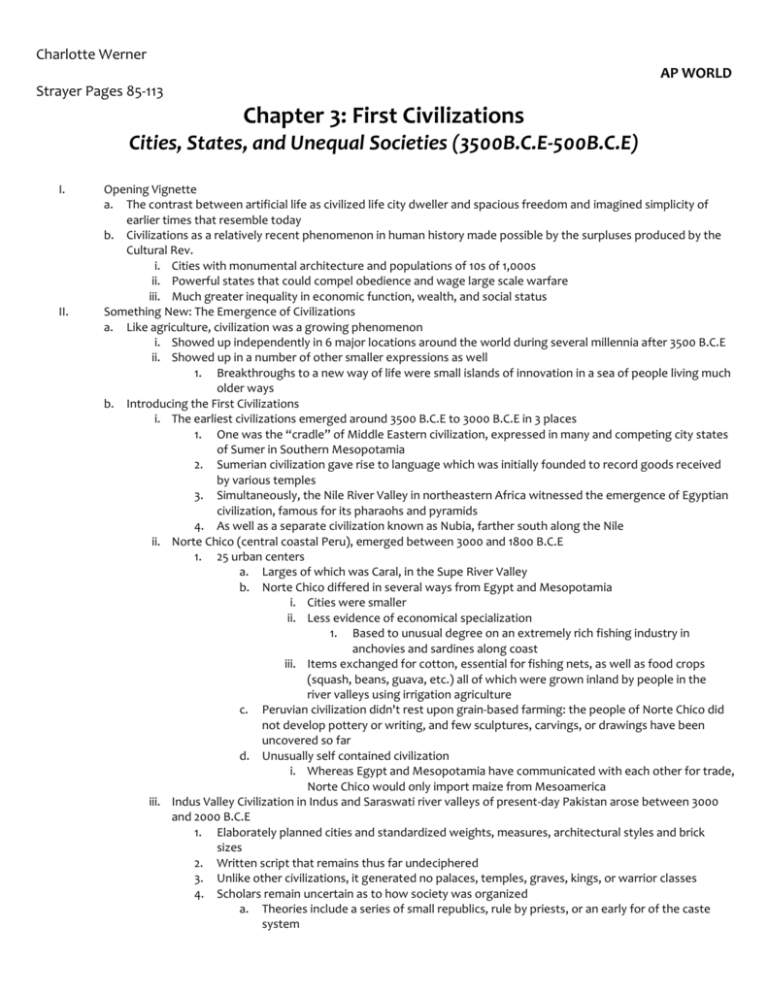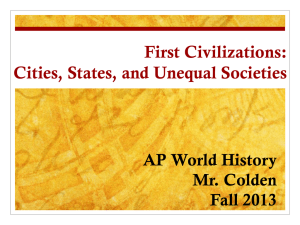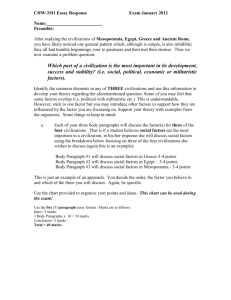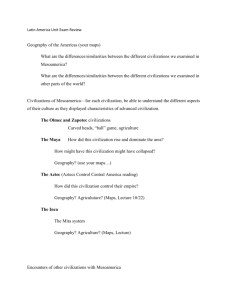Chapter 3: First Civilizations Cities, States, and - Course
advertisement

Charlotte Werner AP WORLD Strayer Pages 85-113 Chapter 3: First Civilizations Cities, States, and Unequal Societies (3500B.C.E-500B.C.E) I. II. Opening Vignette a. The contrast between artificial life as civilized life city dweller and spacious freedom and imagined simplicity of earlier times that resemble today b. Civilizations as a relatively recent phenomenon in human history made possible by the surpluses produced by the Cultural Rev. i. Cities with monumental architecture and populations of 10s of 1,000s ii. Powerful states that could compel obedience and wage large scale warfare iii. Much greater inequality in economic function, wealth, and social status Something New: The Emergence of Civilizations a. Like agriculture, civilization was a growing phenomenon i. Showed up independently in 6 major locations around the world during several millennia after 3500 B.C.E ii. Showed up in a number of other smaller expressions as well 1. Breakthroughs to a new way of life were small islands of innovation in a sea of people living much older ways b. Introducing the First Civilizations i. The earliest civilizations emerged around 3500 B.C.E to 3000 B.C.E in 3 places 1. One was the “cradle” of Middle Eastern civilization, expressed in many and competing city states of Sumer in Southern Mesopotamia 2. Sumerian civilization gave rise to language which was initially founded to record goods received by various temples 3. Simultaneously, the Nile River Valley in northeastern Africa witnessed the emergence of Egyptian civilization, famous for its pharaohs and pyramids 4. As well as a separate civilization known as Nubia, farther south along the Nile ii. Norte Chico (central coastal Peru), emerged between 3000 and 1800 B.C.E 1. 25 urban centers a. Larges of which was Caral, in the Supe River Valley b. Norte Chico differed in several ways from Egypt and Mesopotamia i. Cities were smaller ii. Less evidence of economical specialization 1. Based to unusual degree on an extremely rich fishing industry in anchovies and sardines along coast iii. Items exchanged for cotton, essential for fishing nets, as well as food crops (squash, beans, guava, etc.) all of which were grown inland by people in the river valleys using irrigation agriculture c. Peruvian civilization didn't rest upon grain-based farming: the people of Norte Chico did not develop pottery or writing, and few sculptures, carvings, or drawings have been uncovered so far d. Unusually self contained civilization i. Whereas Egypt and Mesopotamia have communicated with each other for trade, Norte Chico would only import maize from Mesoamerica iii. Indus Valley Civilization in Indus and Saraswati river valleys of present-day Pakistan arose between 3000 and 2000 B.C.E 1. Elaborately planned cities and standardized weights, measures, architectural styles and brick sizes 2. Written script that remains thus far undeciphered 3. Unlike other civilizations, it generated no palaces, temples, graves, kings, or warrior classes 4. Scholars remain uncertain as to how society was organized a. Theories include a series of small republics, rule by priests, or an early for of the caste system 5. III. Environmental degradation led to collapse of this civilization by about 1700 B.C.E., but several aspects of its culture shaped later Indian societies iv. Around 2200 B.C.E., a First Civilization took shape in China 1. From the Start, China was defined by the ideal of a centralized state 2. The Xia, Shang, and Zhou dynasties enlarged the Chinese state 3. Ruler was the “Son of Heaven,” an intermediary between Heaven and Earth 4. Early written language with oracle bones as early documents 5. China has maintained impressive cultural continuity into modern times v. The Olmec produced a First Civilization much later (around 1200 B.C.E.) on coast of Gulf of Mexico, near present-day Veracruz 1. Cities arose form competing chiefdoms and produced elaborate ceremonial centers 2. Created the first written language in Americas by about 900 B.C.E 3. Cultural influenced later civilizations in Mesoamerica, including the Maya and Teotihuacan vi. Smaller civilizations also flourished 1. Nubian civilization of south of Egypt was distinctive and independent 2. City of Sanxingdui in China arose separately from the better-known Shang Dynasty. c. The Question of Origin i. First Civilizations had their roots in the Agricultural Revolution ii. First Civilizations tended to develop from earlier, competing chiefdoms that already had some social rank and economic specialization iii. Process was gradual an evolutionary iv. Some chiefdoms developed into civilizations and others didn’t 1. One argument was that the need to organize large scale irrigation projects was evident (Archeologists have found that these projects appeared long after civilizations began) 2. Another argument was the need of elite groups, warfare, and trade all played roles 3. Robert Carneiro’s argument was that population density quickly created competition, especially when agricultural land was limited v. The creation of the First Civilizations was quick by world history standards but slow for those involved, it was a gradual change. vi. All First Civilizations relied on highly productive agriculture d. Urban Revolution i. Cities were one of the most distinctive features of the First Civilizations ii. The scale, layout, and specialized industries of cities would impress visitors from other villages iii. Cities lay at the heart of all First Civilizations 1. Political and administrative capitals 2. Centers of cultural production—art, architecture, literature, ritual, and ceremony 3. Places of local and long distance exchange 4. Centers of manufacturing activity 5. Cities produced new societies with greater specialization and inequality The Erosion of Inequality a. Professional and craft specialization marked early urban life b. Hierarchies of Class i. First Civilizations had vast inequalities in wealth, status, and power ii. Civilizations multiplied and magnified inequalities that already existed in complex gathering and hunting societies and agricultural chiefdoms iii. New levels of inequality represent one of the major turning points in social history of human kind iv. Upper classes 1. Enjoyed great wealth 2. Avoided physical labor 3. Had the finest in everything 4. Occupied top positions in political, military, and religious life 5. Frequently distinguished by their clothing, houses, manner of burial, treatment under the law v. Free commoners formed the vast majority of the population and included artisans of all kinds, lower-level officials, soldiers and police, servants, and farmers 1. Their surplus production was appropriated to support the upper classes 2. Some members of these classes recognized and resented their situation vi. Slaves were at the bottom of social hierarchies everywhere 1. Slavery and civilization seem to have emerged together IV. 2. First-generation slaves were prisoners of war, criminals, and debtors 3. Worked in fields, mines, homes, and shops 4. Rarely, they were sacrificed 5. Slavery varied from place to place (geographical region) 6. Most ancient slavery different from American slavery c. Hierarchies of Gender i. Civilizations everywhere undermined the earlier and more equal relationship between man and woman ii. Women in horticultural societies remained relatively equal to men iii. Patriarchy gradually emerged in First Civilizations 1. More intensive agriculture with animal-drawn plows and large dairy herds favored male labor over female 2. Patriarchy also developed in civilizations without plow agriculture, such as Mesoamerica and the Andes 3. David Christian: the declining position of women was a product of grown social complexity 4. The association of women with nature because of role in reproduction may have also been a part of the whole 5. Warfare contributed to patriarchy 6. Private property and commerce d. Patriarchy in Practice i. Gerda Lerner: emergence of patriarchy in Mesopotamia 1. Written law of codes codified patriarchal family life 2. Regulation of female sexuality was central 3. Women in Mesopotamia were sometimes divided into two sharply distinguished categories, depending on protection of one man 4. Powerful goddesses of Mesopotamia were gradually replaced by male deities ii. Egyptian patriarchy gave women greater opportunities than in most First Civilizations 1. Own property and slaves 2. Administer and sell land 3. Make their own wills 4. Sign their own marriage contracts 5. Initiate divorce iii. Royal women occasionally wielded political power as regents for their sons or more rarely, as queens in their own right iv. Egyptian statues and love poetry suggest affection between sexes The Rise of the State a. States were central to the organization and stability of First Civilizations b. Coercion and Consent i. The state fulfilled a variety of roles in coordinating and regulating First Civilizations 1. Organizing irrigation systems 2. Adjudicating conflicts 3. Defense ii. The state served the needs of the upper classes 1. Protecting the privileges of the elite class 2. Requiring farmers to give up a portion of the product to support city people 3. Demanding labor on large public projects 4. The state will frequently used force to secure its will 5. Force was not always necessary because the state often claimed that its authority was normal, natural, and ordained by the gods a. Ruled by divine right b. Deference to religion restrained or even undermined the right to rule as in the rule of the Chinese emperors by the Mandate of Heaven c. Writing and Accounting i. Writing provided support for the state and emerged in all of the First Civilizations except the Andes (though some scholars regard the knotted string, or quipus for accounting, as a kind of writing) ii. Writing sustained the First Civilizations 1. Defining elite status and conveying prestige on those who wrote 2. Allowing some commoners to join the elite through literacy 3. Providing a means for propaganda V. 4. Providing a means to keep accurate accounts and complex calendars 5. Giving weight to regulations and laws iii. Writing served as a function beyond the state 1. Fostered literature, philosophy, astronomy, mathematics, history 2. Sometimes threatened rulers d. The Grandeur of Kings i. Source of state authority ii. Monumental residences and temples iii. Luxurious dress iv. Elaborate burials Comparing Mesopotamia and Egypt a. Environment and Culture i. Both depended on rivers, but were very different 1. Erratic and destructive flooding in Mesopotamia 2. Nile flooded more predictably and less destructively ii. Mesopotamia was less geographically isolated than that of Egypt 1. It was more vulnerable to attacks from external forces 2. Egypt was more protected from external attack iii. Relationship between physical setting and culture 1. More negative Mesopotamian worldview seems to reflect its precarious and violent environment 2. Egyptian worldview reflected a more stable, predictable and beneficial environment in which it started to take shape b. Cities and states i. The political system of Mesopotamia and Egypt differed sharply ii. Mesopotamia for its first thousand years was organized into a dozen or more separate city-states 1. Each city-state was rule by a king 2. 80% of the population lived in city-states a. Protection 3. Environmental devastation and endemic warfare ultimately led to conquest by outside forces after about 2350 B.C.E 4. These outside powers built large territorial states or bureaucratic empires encompassing all or most of Mesopotamia. iii. Egypt 1. Around 3100 B.C.E. several earlier states and chiefdoms merged into a unified territory that stretched some 1,000 miles along the Nile 2. For 3,000 years, Egypt maintained unity and independence 3. The pharaoh was the focus of Egyptian state a. God in human form 4. From 2200 B.C.E. to 2000 B.C.E there was anarchy a. When state was restored, pharaohs never regained their power iv. Interaction and Exchange 1. Egypt and Mesopotamia frequently interacted 2. Egypt’s agriculture benefitted from interaction 3. Mesopotamian models may have influenced Egypt’s step pyramids and language (writing) 4. Civilization derives from its implication of solidity—the idea that civilizations represent distinct and widely shared identities with clear boundaries that mark them off from others. a. Unlikely however, that people of Mesopotamia, Norte Chico, or China felt part of a shared culture b. Local identities were defined by clan affiliation, occupation, village, city, or region






